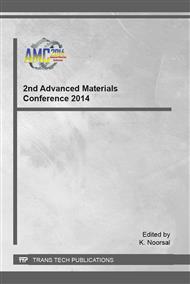p.515
p.523
p.527
p.532
p.537
p.542
p.547
p.552
p.557
Development of Ionothermal Synthesis of Titania Nanomaterial for Waste-Water Treatment
Abstract:
In this study, ionothermal synthesis process has been used for the preparation of two different types of Titania nanomaterials and that were utilized in the degradation of waste-water like (sulfan blue). The ionic liquid were used as 1-butyl-3-methylimidazolium dimethyl phosphate ([Bmim] DMP) as (TP) and 1-butyl-3-methypyridium dicyanamide ([Bmpm]DCN) as (TCN) respectively for the synthesis of anatase type Titania nanomaterials and confirmed with X-Ray diffraction pattern (XRD). The particle sizes and surface morphology were characterized by field emission scanning electron microsopy (FESEM), transmission electron microscopy (TEM), and Brunauer-Emmett-Teller (BET). The sizes of the particle were found to be approximately 35±5 nm from the microscopic picture analysis. The nitrogen adsorption analysis measured a surface area of 455 and 220 m2 g-1 and pore volume of 0.25 and 0.15 cm3 g-1 for ([Bmim]DMP) and ([Bmpm]DCN) related synthesis TiO2 nanomaterials respectively. The degradation rate of sulfan blue is higher in the presence of TP as compared to TCN owing to the larger surface area.
Info:
Periodical:
Pages:
537-541
Citation:
Online since:
January 2016
Keywords:
Price:
Сopyright:
© 2016 Trans Tech Publications Ltd. All Rights Reserved
Share:
Citation:


